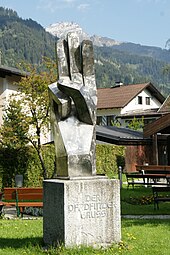Boy scout greeting
The boy scout greeting is a greeting that scouts give themselves worldwide. When greeting the boy scout, you hold out your left hand, coming “from the heart”, while the right hand is raised up to about shoulder height. The index, middle and ring fingers point upwards and the thumb rests on the little finger. Sometimes it is common to bend the arm to the head when wearing a head covering (scout hat, beret ).
The greetings used in German-speaking countries are Always Ready or Gutpfad , the English Be prepared (Be prepared) is internationally known .
right hand

The right hand sign has the following meaning:
- The three upright fingers stand for the three points of the Boy Scout promise (obligation to God, obligation to others and obligation to yourself / the Boy Scout Law) and for the three leaves of the lily or the shamrock (which each have the same meaning). In some scout associations there is also the interpretation “loyal, honest and helpful”.
- The thumb ( the strong ) protects the little finger ( the weak ).
handshake
Scouts reach out to greet each other, in contrast to the usual handshake with their left hand . This form of greeting was introduced by Robert Baden-Powell as a "secret sign".
There are various attempts to explain this:
- The left hand comes from the heart.
- An African tribe is said to have honored men with outstanding achievements in this way.
- Two warring African tribes laid down their shields after the peace agreement and then gave each other the unprotected left hand as a sign of peace.
- Baden-Powell got to know the greeting with the left hand in 1895 during the war against the Ashanti , where it was used by the Krobo tribe, who distinguished themselves through courage, reliability and special achievements.
In Germany and some other European countries, it is common to spread the little finger of the left hand when shaking hands. As a result, the hands are also interlocked, which is intended to symbolize the (worldwide) bond. Another explanation ascribes this to a common hallmark in the early resistance against National Socialism . If you spread your little finger, but not the other, you only notice it yourself, the other's finger goes into space.
Wolf salute
With the wolves, the children between 7 and 11 years, there is the wolf greeting instead of the boy scout greeting. The index and middle fingers of the right hand are spread apart to symbolize the wolf's ears; the thumb also protects the little finger here and the ring finger too. In some German-speaking alliances their own greeting "Gut Jagd" is used. In Switzerland, the girls, the Bienli, also have their own greeting; it is almost the same as that of the wolves, except that the fingers are not spread but held together to show solidarity.
Beaver salute
Some frets also have a level with children under 7, the beaver level. As for the wolves, there is a special boy scout greeting, in which the index and middle fingers of the right hand imitate beaver teeth by spreading them with two angled phalanges. As with the other greetings, the thumb rests on the small and ring finger and symbolizes the protection of the larger over the smaller. "Good friend" is used as a greeting.
Web links
Individual evidence
- ^ Piet Strunk: The Scouts in Germany 1909–2009. Novum Pro, Neckenmarkt 2010. ISBN 978-3-9900324-6-6 . P. 120 f.

